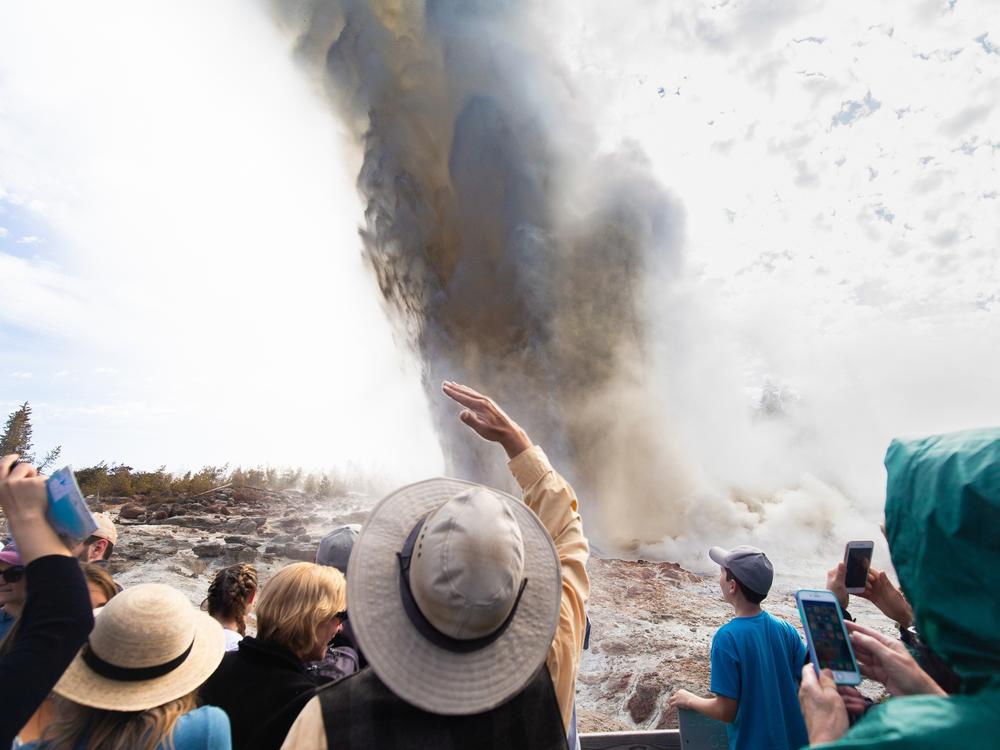Section Branding
Header Content
When Steamboat goes WHOOSH, scientists look for answers
Primary Content
Steamboat is the world’s tallest active geyser, but unlike Old Faithful, its eruptions are completely unpredictable.
Now, a new analysis suggests that at least one recent Steamboat eruption got triggered by a small earthquake.
The 3.9 earthquake occurred in September of 2022, and its epicenter was around 7 miles from Steamboat, which is in the Norris Geyser Basin of Yellowstone National Park in Wyoming.
“Somebody ran down there immediately after the earthquake to see if Steamboat was doing anything, and right after the earthquake, it looked normal,” recalls Mara Reed, a graduate student at the University of California, Berkeley.
About eight hours later, though—whoosh!
Steamboat had one of its major eruptions, which can send water hundreds of feet up into the air.
Reed and some colleagues wondered if the two events were connected, and did an analysis that was just published in the journal Volcanica.
“We definitely think it's plausible. I would argue it's probably what happened,” says Reed.
The report comes just days after Steamboat had another eruption that closely followed an earthquake. This one was a 4.1 trembler with an epicenter about 100 miles away from the geyser.
“I think it’s really intriguing. And it strikes me as perfectly viable that a geyser that’s close to erupting might be pushed over the edge by some seismic shaking,” says Michael Poland of the U.S. Geological Survey, who heads the Yellowstone Volcano Observatory.
“But it’s really, really hard to prove beyond a shadow of a doubt,” he says, “because it’s always possible that it was just coincidence.”
Rockstar geyser
The world only has about a thousand geysers, and around half are in Yellowstone.
Besides being interesting in and of themselves, they are good analogues for volcanoes. About a tenth of the world’s population lives within the potential range of volcanic hazards, so researchers are keen to understand what can set one off.
“We have known for a long time that earthquakes trigger volcanic eruptions, but understanding when and why remain open questions,” says Michael Manga of the University of California, Berkeley.
“Geysers provide another opportunity to study how stress affects fluids,” he notes, because the underlying physics is similar.
In the world of geysers, Steamboat is kind of a rock star.
It’s huge, and can also inexplicably go dormant for years. When it wakes up and becomes active, eruptions can occur every few days. Or, they can be separated by weeks to months.
“Steamboat is special. Steamboat right now is the king,” says Poland. “It has these eruptions that will go up maybe 400 feet, and part of the mystique, perhaps, is that it’s not predictable.”
Scientists have installed some seismometers near Steamboat, and these instruments can pick up the tiny vibrations in the ground caused by hot, boiling water.
“Imagine if you see a pot of boiling water on the stove, it’s pretty vigorous,” says Poland.
After the 2022 earthquake, one instrument close to Steamboat registered a change in the intensity of this hydrothermal noise, says Reed.
That means the earthquake may have altered the fluid flow underground and sent more hot water in the direction of Steamboat.
“So we know that the hydrothermal system at that point near the seismometer was changed,” she says. “That doesn't necessarily prove that it changed in a way that affected Steamboat, but it's plausible that it did, based on what we know about the geology, the area, and sort of the exact types of seismic signals we were seeing.”
The research team also did a statistical analysis showing that there was a very low probability that Steamboat would have erupted on that day just by chance.
Bigger quakes
Poland says for about two months before that major eruption, Steamboat seemed to be primed to go off.
It had been experiencing a bunch of minor eruptions that sent water splashing only 10 feet or so above its vent.
The same was true this month on October 7, when a 4.1 earthquake occurred near Dillon, Montana, about 100 miles from Steamboat.
Hours later, Steamboat had a major eruption.
Maybe, in both cases, Steamboat was close to erupting and the quake just gave it a push, says Poland.
“If so, in both cases, why was there a delay of several hours between earthquake and eruption?” he wonders.
Steamboat has experienced several big regional quakes without erupting. For example, it did not erupt after the 7.3 Hebgen Lake earthquake that affected many other Yellowstone geysers.
Reed notes that big earthquakes are likely to open up more new cracks and fluid pathways underground, but when that quake occurred in 1959, Steamboat was not in an active phase.
“It probably does just need to be primed to erupt,” says Reed.
The same seems to be true for volcanoes, she says.
“Probably the internal state of the volcano is very important,” says Reed. “The volcano has to be sort of already primed to erupt for an earthquake to come along and just give it that little extra nudge.”

